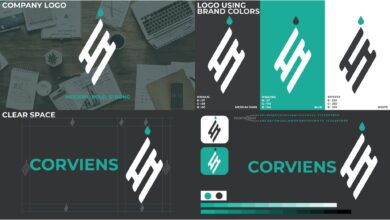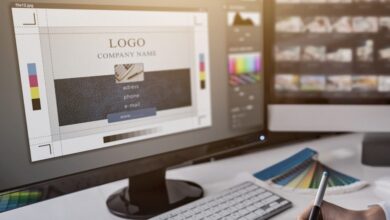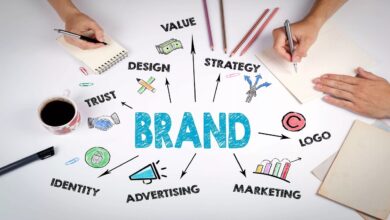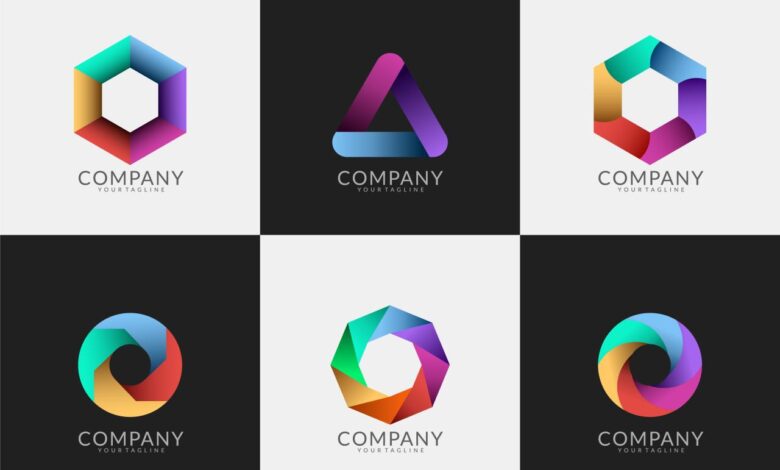
Logo Design for the Modern World
Logo design for the modern world isn’t just about creating a pretty picture; it’s about crafting a visual identity that resonates deeply with your target audience and effectively communicates your brand’s essence in today’s fast-paced, digitally driven landscape. We’ll explore the key elements that define a modern logo, from minimalist aesthetics and impactful typography to the psychology of color and the crucial role of digital adaptability.
Get ready to dive into the fascinating world of branding and discover how a well-designed logo can be the cornerstone of your success.
This journey will cover everything from understanding the principles of modern design – minimalism, simplicity, and impactful typography – to navigating the complexities of color psychology and ensuring your logo works seamlessly across all digital platforms. We’ll also touch on the increasingly important aspects of sustainability and ethical considerations in logo design, shaping a brand identity that reflects your values as much as your product or service.
Defining “Modern” in Logo Design: Logo Design For The Modern World
Defining “modern” in logo design is a dynamic challenge, as trends constantly evolve. It’s not simply about using the latest software or following fleeting fads; it’s about reflecting contemporary sensibilities and communicating a brand’s values in a way that feels relevant and fresh to today’s audience. This means understanding the underlying visual language that characterizes modern design and how it differs from previous eras.Modern logo design prioritizes clean lines, minimalist aesthetics, and a focus on functionality.
It often utilizes geometric shapes, sans-serif typefaces, and a muted color palette, eschewing overly decorative elements or complex imagery in favor of simplicity and clarity. This contrasts sharply with previous decades, particularly the ornate styles of the Victorian era or the bold, sometimes cluttered designs of the 1980s. The shift towards minimalism reflects a broader cultural preference for efficiency and direct communication.
Key Visual Characteristics of Modern Logos
Modern logos are characterized by their simplicity and versatility. They often feature a single, memorable symbol or a concise typographic mark. The color palette is typically subdued, often using a limited number of colors to create a sense of sophistication and timelessness. The overall aesthetic is clean and uncluttered, prioritizing legibility and recognizability across various applications, from business cards to digital interfaces.
This approach ensures the logo remains effective regardless of size or context.
Comparison of Modern and Past Logo Design Trends
The evolution of logo design mirrors broader societal shifts. Early 20th-century logos often featured elaborate illustrations and Art Deco influences. Mid-century designs frequently employed bold, geometric shapes and a strong emphasis on color. The 1980s saw a surge in complex, three-dimensional logos with gradients and drop shadows. In contrast, modern logos prioritize simplicity and flat design, echoing the minimalist aesthetic prevalent in contemporary web design and user interface (UI) trends.
This shift reflects a move towards cleaner, more intuitive communication.
Examples of Modern Logos and Their Effectiveness
The Apple logo, a simple, stylized apple, is a prime example of modern logo design’s effectiveness. Its simplicity and recognizability are unparalleled. Similarly, the Nike swoosh is instantly recognizable and communicates dynamism and movement through its elegant curve. These logos achieve impact through their minimalist approach, making them easily adaptable to various applications and highly memorable. Their effectiveness lies in their ability to convey a brand’s essence concisely and memorably.
The Mastercard logo, with its interlocking circles, is another strong example of a modern logo that uses simple shapes to create a powerful and recognizable brand identity.
Designing a logo for today’s market means considering every platform, and that includes video. A strong visual identity needs to translate well across all mediums, which is why understanding how to leverage video platforms is crucial. Check out this great guide on getting it on with youtube to boost your brand’s visibility. Ultimately, a well-crafted logo, coupled with a smart YouTube strategy, can be the key to unlocking real brand growth in the modern world.
Modern Logo Concepts for a Hypothetical Tech Startup
Let’s imagine a hypothetical tech startup called “Synapse.” Here are three distinct modern logo concepts:
- Concept 1: A stylized brain Artikel formed by interconnected nodes, using a gradient of blues and greens to suggest connectivity and intelligence. This logo is effective because it visually communicates the company’s focus on technology and brain-related applications. The color palette evokes a sense of trust and innovation.
- Concept 2: A simple, geometric icon representing a circuit board, utilizing a clean sans-serif typeface for the company name. The color palette consists of a deep navy blue and a bright accent color like orange, creating a contrast that is both modern and memorable. This option is strong due to its clear representation of the tech industry. The color contrast makes it stand out.
- Concept 3: A minimalist, abstract symbol – perhaps a stylized lightning bolt or a connected network of dots – paired with a clean, modern sans-serif font. The color scheme is monochromatic, using shades of grey to convey a sense of sophistication and reliability. This design is effective because of its versatility and timeless appeal; the abstract nature allows for flexibility in application and interpretation.
Typography and Modern Logo Design
Typography plays a crucial role in shaping a brand’s visual identity, and its importance is magnified in the context of modern logo design. A well-chosen typeface can instantly communicate a brand’s personality, values, and target audience. The right font can make a logo memorable, impactful, and timeless, while the wrong one can make it look dated, generic, or even unprofessional.
Modern logo design often prioritizes clean, legible, and versatile typography that can adapt to various applications, from business cards to website banners.
The Role of Font Styles in Modern Logos
Different font styles – serif, sans-serif, and script – each possess unique characteristics that lend themselves to different branding objectives. The choice of font style directly impacts the overall impression a logo creates. Understanding these nuances is essential for crafting a modern and effective visual identity.
Serif, Sans-Serif, and Script Fonts in Modern Logo Design
Serif fonts, characterized by small decorative strokes at the ends of letters, often convey a sense of tradition, sophistication, and elegance. While sometimes perceived as less modern, they can still be used effectively in contemporary logos, particularly when paired with a minimalist design. A classic example is the Times New Roman font, although it’s rarely used in logos for its heavy weight and lack of modern appeal.
However, more modern serif fonts with thinner strokes and a cleaner feel can work well. Think of the subtle serifs in a logo designed for a high-end law firm, communicating trustworthiness and authority.Sans-serif fonts, lacking these decorative strokes, generally project a clean, modern, and minimalist aesthetic. They are incredibly popular in modern logo design due to their versatility and readability across various sizes and mediums.
Logos for tech companies frequently employ sans-serif fonts, reflecting innovation and simplicity. Examples include Google’s logo (using a custom sans-serif), and many others that utilize fonts like Helvetica or Open Sans.Script fonts, mimicking handwritten lettering, often evoke feelings of personality, creativity, and elegance. However, they should be used cautiously in logo design, as excessive use or improper selection can result in illegibility or a lack of professionalism.
They are best suited for brands that want to project a more artistic or personal touch, perhaps a boutique or a handwritten-style brand. The key is balance and clarity; a script font should be easily readable even at small sizes.
Comparison of Font Families for Modern Logos
| Font Family | Characteristics | Potential Applications | Example |
|---|---|---|---|
| Open Sans | Clean, versatile sans-serif; highly legible; works well in various sizes and contexts. | Technology, healthcare, education, corporate branding. | Imagine a clean, simple logo for a tech startup, using Open Sans in a bold, slightly condensed weight. |
| Montserrat | Geometric sans-serif; modern and stylish; strong and confident feel. | Finance, fashion, luxury brands, fitness. | Envision a logo for a high-end fitness brand, using Montserrat in a sleek, all-caps design. |
| Playfair Display | Elegant serif; sophisticated and refined; works well for headlines and smaller text elements. | Luxury goods, publishing, hospitality, design firms. | Consider a logo for a luxury hotel, where Playfair Display might be used for the hotel name, paired with a simpler sans-serif for secondary text. |
Color Psychology and Modern Branding
Color is more than just aesthetics in modern logo design; it’s a powerful tool for communication, instantly conveying brand personality, values, and even emotions. A well-chosen color palette can significantly impact a brand’s memorability and effectiveness, while a poor choice can lead to misinterpretations and hinder brand recognition. Understanding color psychology is crucial for creating a logo that resonates with the target audience and effectively communicates the brand’s message.Color psychology explores the effects of different colors on human perception and behavior.
Each color evokes specific associations and feelings, influencing how consumers perceive a brand. For example, blue often signifies trust and stability, while green represents growth and environmental consciousness. Red can convey excitement and urgency, while yellow suggests optimism and happiness. However, these associations are not universal and can vary across cultures. Therefore, careful consideration of the target audience’s cultural background is essential when selecting colors for a logo.
Examples of Effective Color Use in Logos
Several successful brands have leveraged color psychology to their advantage. Consider the iconic Coca-Cola logo, which utilizes a vibrant red. Red is associated with energy, excitement, and appetite, perfectly aligning with the brand’s image and product. Conversely, the calming blue of the Skype logo projects feelings of trust and reliability, fitting for a communication platform. The green of the Whole Foods Market logo subtly communicates their commitment to natural and organic products, appealing to environmentally conscious consumers.
These examples showcase how thoughtful color choices can reinforce a brand’s identity and resonate deeply with its target market.
Color Palette for a Modern Sustainable Energy Company
For a modern sustainable energy company, a color palette should communicate trustworthiness, innovation, and environmental responsibility. I propose a palette incorporating three core colors:
- Deep Teal (#008080): This sophisticated shade of blue-green evokes feelings of stability, trust, and environmental consciousness. It suggests a connection to nature and the ocean, representing the clean and sustainable energy the company provides.
- Solar Yellow (#FFD700): A bright, optimistic yellow represents the sun, the primary source of solar energy. It adds a touch of vibrancy and optimism, conveying the innovative and forward-thinking nature of the company.
- Forest Green (#228B22): A darker, more subdued green reinforces the company’s commitment to environmental sustainability. It provides a grounding element to the palette, balancing the brighter yellow and suggesting reliability and growth.
This palette avoids overly bright or jarring colors, instead opting for a balanced and sophisticated combination that projects professionalism and environmental responsibility. The combination of deep teal, solar yellow, and forest green creates a visual identity that is both modern and trustworthy, effectively communicating the brand’s values and attracting environmentally conscious consumers.
Simplicity and Minimalism in Modern Logos
In today’s fast-paced digital world, cluttered designs are easily overlooked. A simple, minimalist logo cuts through the noise, making a lasting impression and fostering brand recognition. This approach prioritizes clarity and memorability, ensuring the logo remains effective across various applications and sizes. The power of less is more is undeniably at play here.Minimalist logo design is about focusing on the core essence of a brand, stripping away unnecessary elements to reveal a powerful, memorable symbol.
This isn’t about lazy design; it’s a strategic approach that demands careful consideration of form, color, and typography to create a logo that’s both visually appealing and highly effective. It’s a testament to the power of intentional design.
Examples of Minimalist Logos and Their Effectiveness
The effectiveness of minimalist logos lies in their ability to convey a brand’s identity concisely and memorably. Consider the Apple logo: a simple, bitten apple. Its clean lines and single color are instantly recognizable globally, representing innovation and user-friendliness without needing elaborate details. Similarly, the Nike swoosh, a single, dynamic curve, conveys movement, speed, and athleticism. The simplicity of these designs allows them to be instantly understood and easily remembered, transcending cultural and linguistic barriers.
These iconic examples prove that less can indeed be more. Another example is the Twitter bird – a simple, stylized blue bird – which perfectly captures the essence of quick communication and social networking. The logo’s clean lines and recognizable shape make it instantly identifiable.
Design Principles for Minimalist and Effective Logos
Creating a truly minimalist logo requires careful attention to several key design principles. A successful minimalist logo is not simply devoid of elements; it’s a carefully curated composition.
Before listing these principles, it’s important to understand that minimalism isn’t about creating something bland. It’s about strategic reduction, focusing on the most essential elements to communicate a brand’s message effectively. It’s about refining the design until only the core essence remains.
- Limited Color Palette: Using a single color or a very limited palette ensures visual clarity and prevents the logo from becoming overwhelming. The focus remains on the form and shape.
- Simple Shapes: Geometric shapes like circles, squares, and triangles are often used as they are easily recognizable and versatile. Complex shapes can detract from the overall minimalism.
- Clean Typography: A simple, legible font is crucial. Avoid overly decorative or ornate typefaces that can clash with the minimalist aesthetic.
- Negative Space: Effectively utilizing negative space is key. The space around the logo elements is just as important as the elements themselves, contributing to the overall visual impact and creating a sense of balance and sophistication.
- Versatility and Scalability: A minimalist logo should remain recognizable and effective at various sizes, from a small favicon to a large billboard. This requires careful consideration of the design elements and their proportions.
Logo Design for Digital Platforms

Source: fbcd.co
Designing logos for the digital age presents unique challenges compared to traditional print media. The ever-evolving landscape of websites, mobile apps, and social media platforms demands flexibility, scalability, and a keen understanding of user experience. A logo that looks stunning on a high-resolution website might appear blurry and pixelated on a small smartphone screen, highlighting the need for careful consideration of various display parameters and formats.The visual requirements for a logo differ significantly depending on the platform.
A website logo can afford more intricate detail and a larger size, allowing for subtle nuances in design and typography to be easily perceived. Conversely, a mobile app logo needs to be highly simplified and easily recognizable even at very small sizes, often appearing within constrained spaces alongside other app icons. The focus should be on immediate clarity and memorability, as users interact with these icons frequently but briefly.
Visual Requirements for Website Logos
Website logos benefit from higher resolution and larger display sizes. This allows for the incorporation of more detailed elements, gradients, and subtle typography without sacrificing visual clarity. The design can be more complex, incorporating a richer visual language to communicate the brand’s identity more comprehensively. For example, a logo for a high-end design firm might feature a sophisticated serif typeface and a carefully crafted emblem, details that would be lost at smaller scales.
Conversely, a logo for a blog might be simpler, possibly just a stylized text-based logo.
Visual Requirements for Mobile App Logos
Mobile app logos demand simplicity and clarity. They need to be easily recognizable at very small sizes, often as small as 24×24 pixels. Intricate details and gradients are generally discouraged, as they can appear muddy or distorted at such small scales. A strong, easily identifiable symbol, often coupled with a concise and legible typeface, is crucial for effective communication.
Think of the iconic Apple logo – its simplicity ensures immediate recognition, even at miniature sizes. The design should also be tested across various screen resolutions and aspect ratios to guarantee consistent appearance and readability.
Guidelines for Adapting Logos Across Digital Platforms
Adapting a logo for different digital platforms requires a structured approach to maintain consistency and brand recognition. The following guidelines are critical:
To ensure consistent brand representation, creating multiple versions of your logo is essential. This includes variations optimized for different uses:
- Primary Logo: The main logo, used in high-resolution contexts like website headers and marketing materials. This version can include greater detail and complexity.
- Favicon: A small, square version of the logo (typically 16×16 or 32×32 pixels) used as a website or app icon in browser tabs and on the home screen.
- Social Media Logos: Variations optimized for various social media platforms, often requiring specific aspect ratios and sizes. These versions might need to be simpler and more streamlined.
- Mobile App Icon: A highly simplified and recognizable version, optimized for small screen sizes and various resolutions. This often involves a single, strong symbol.
Beyond creating variations, consider these points:
- Scalability: The logo should scale effectively without losing clarity or becoming pixelated. Vector graphics (like SVG) are ideal for this purpose.
- Color Consistency: Maintain consistent color palettes across all platforms. Use precise color codes (hex values) to ensure accurate reproduction.
- Testing: Thoroughly test the logo across various devices, browsers, and screen sizes to identify and resolve any rendering issues.
- File Formats: Provide logos in appropriate file formats for each platform. For example, PNGs for sharp images with transparency, and SVGs for scalability.
The Role of Symbolism and Iconography
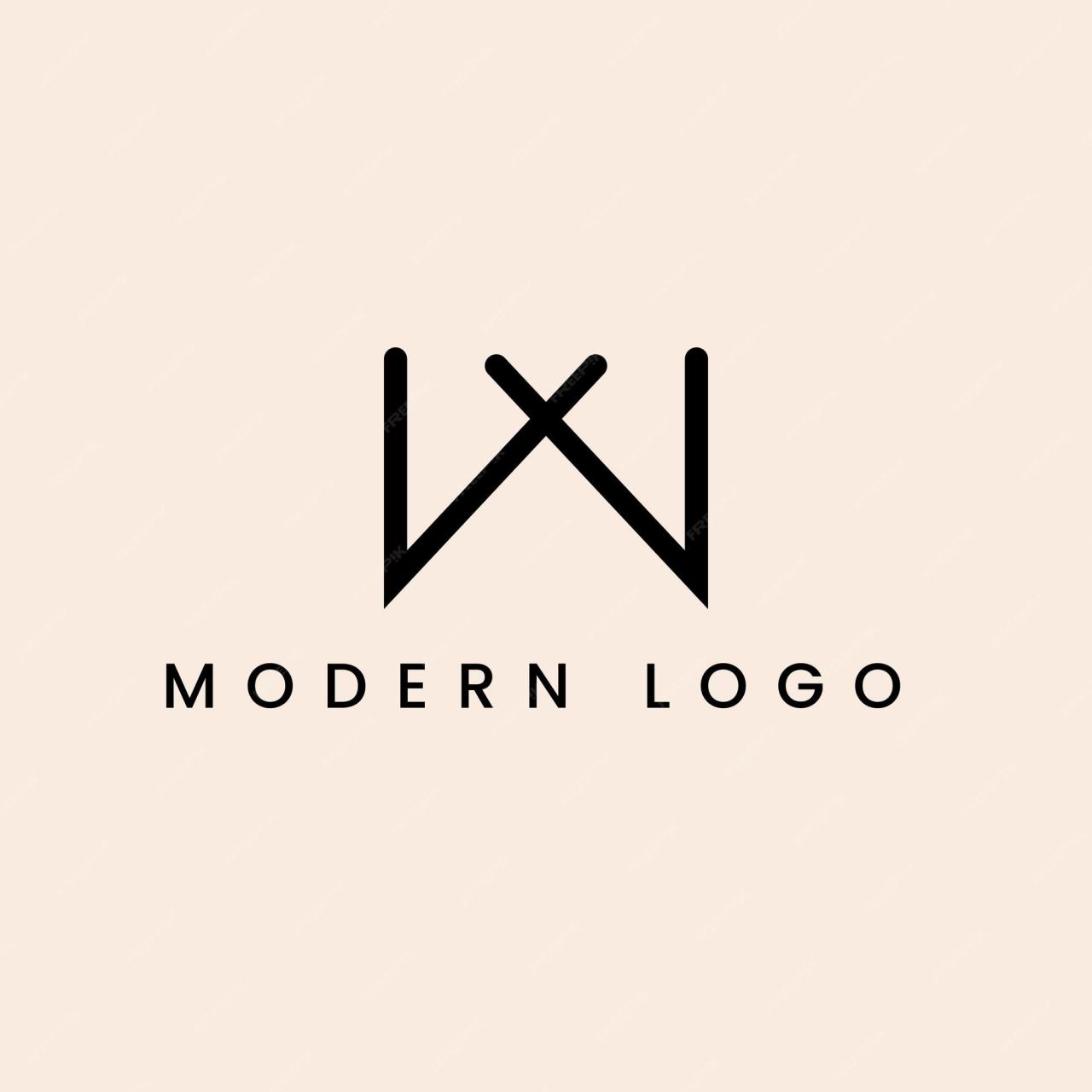
Source: freepik.com
In the modern landscape of logo design, symbolism and iconography are not mere decorative elements; they are powerful tools that communicate brand identity instantly and memorably. A well-chosen symbol can transcend language barriers and resonate deeply with the target audience, forging a connection that goes beyond mere visual appeal. The effective use of symbolism elevates a logo from a simple identifier to a potent brand ambassador.A successful logo often leverages established visual metaphors to convey meaning efficiently.
Consider the instantly recognizable swoosh of Nike, representing movement and speed, or the apple bitten into, signifying innovation and a playful disruption of the status quo. These icons are effective because they are simple, memorable, and directly related to the brand’s core values and offerings. The process of selecting appropriate symbols involves a deep understanding of the brand’s personality, target audience, and competitive landscape.
Common Symbols and Their Effectiveness
Modern logo design frequently utilizes abstract shapes, geometric forms, and natural imagery to convey specific brand attributes. Circles often represent unity, completeness, or global reach. Triangles can symbolize stability, strength, or ambition. Squares and rectangles convey reliability, structure, and order. Natural imagery, such as leaves or mountains, can evoke feelings of growth, resilience, or connection to nature.
The effectiveness of these symbols depends on their careful integration into the overall design and their relevance to the brand’s identity. For example, a technology company might use abstract geometric shapes to represent innovation and precision, while an eco-friendly brand might opt for natural imagery to emphasize sustainability.
Selecting Appropriate Symbols for a Specific Brand, Logo design for the modern world
The selection process begins with thorough brand research. This involves defining the brand’s mission, vision, values, and target audience. Next, brainstorming sessions generate a range of potential symbols that align with the brand’s attributes. These ideas are then evaluated based on their memorability, scalability (ability to be used at various sizes), versatility (adaptability across different media), and overall aesthetic appeal.
Finally, the selected symbol is rigorously tested through market research to ensure it resonates positively with the target audience. This multi-stage process guarantees a logo that effectively communicates the brand’s essence.
Symbolic Representations for a Financial Planning Company
We’ll design three different symbolic representations for a hypothetical financial planning company, “ProsperPath Financial”:
- A stylized upward-trending line graph: This symbol directly represents financial growth and progress, core promises of a financial planning service. The clean lines and positive trajectory communicate stability and future-oriented thinking. The color scheme could incorporate shades of green to represent growth and stability.
- An abstract representation of a compass rose: A compass rose, symbolizing guidance and direction, subtly hints at the company’s role in navigating clients’ financial journeys. The design could be simplified and modernized for a clean, contemporary look, perhaps using a geometric interpretation rather than a literal depiction. A color palette of blues and golds could convey trust and prosperity.
- A stylized tree with strong roots and upward-reaching branches: This symbol represents the long-term growth and stability that financial planning aims to achieve. The strong roots symbolize a solid foundation, while the upward-reaching branches represent future growth and prosperity. A palette of browns and greens would reinforce the natural growth imagery. The tree could be simplified to a more abstract form to maintain a modern aesthetic.
Sustainability and Ethical Considerations
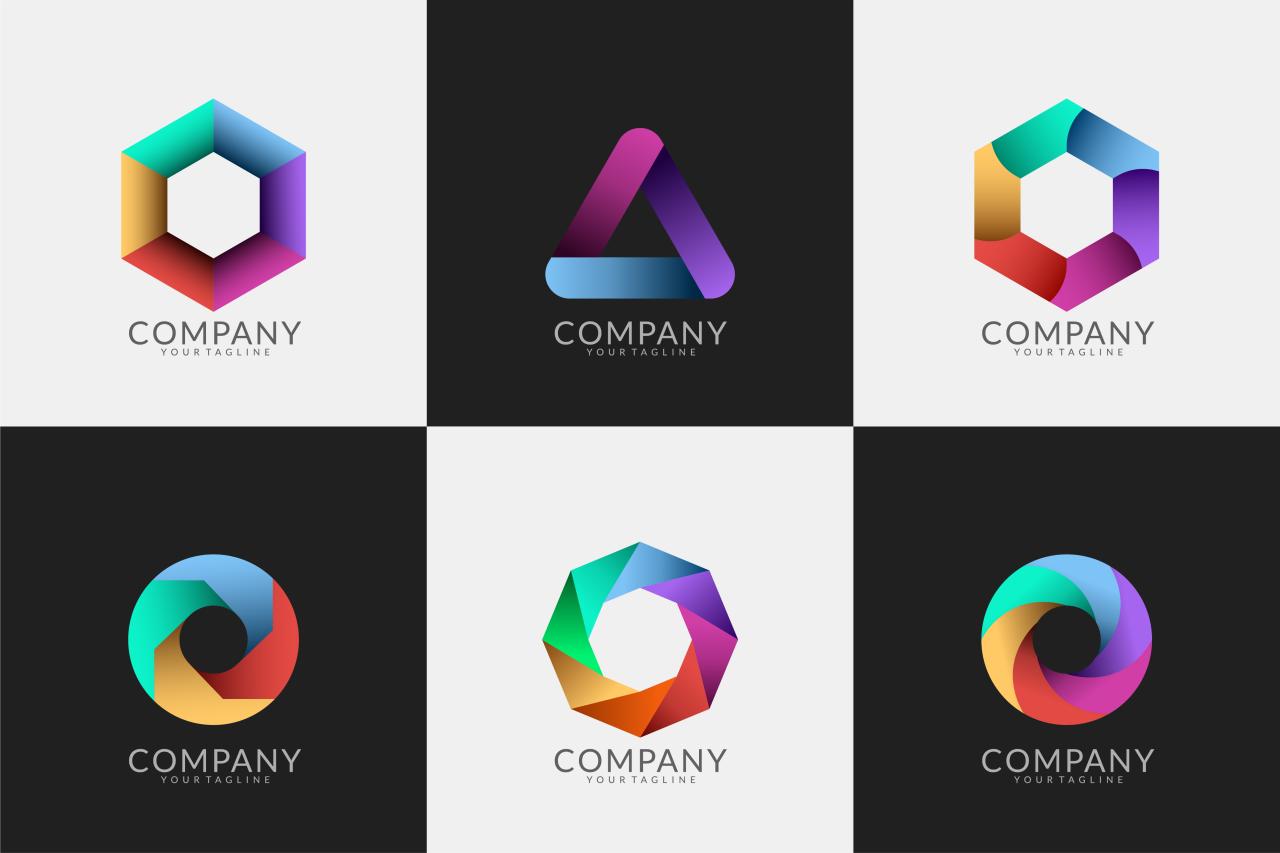
Source: vecteezy.com
In today’s increasingly conscious world, consumers are demanding more than just a product; they’re seeking brands that align with their values. This shift in consumer behavior has placed a significant emphasis on sustainability and ethical considerations, extending its influence even into the seemingly superficial realm of logo design. A logo, as the visual representation of a brand, now carries the responsibility of reflecting a company’s commitment to environmental and social responsibility.A logo can communicate a company’s dedication to sustainability through various visual cues and design choices.
The selection of eco-friendly materials for physical branding, such as recycled paper for business cards or sustainable inks for printed materials, directly supports this message. However, the visual language of the logo itself also plays a crucial role. The use of natural color palettes, imagery that evokes nature (leaves, water, mountains), or even the choice of a typeface that suggests simplicity and authenticity can subtly convey a brand’s commitment to ethical practices.
Sustainable Design Practices in Logos
Many companies are now integrating sustainable design practices directly into their logos. This goes beyond simply choosing a green color; it involves considering the entire lifecycle of the logo’s creation and use. For example, a logo designed using vector graphics requires fewer resources to reproduce than a complex raster image. Furthermore, the use of readily available fonts, rather than custom-created ones, reduces the environmental impact associated with font creation and licensing.
Patagonia’s logo, while simple, uses a minimal color palette and clean lines, reflecting their brand’s commitment to environmentalism. Similarly, many organic food companies utilize imagery directly related to nature, such as leaves or fruits, to visually communicate their sustainable sourcing and production methods. The imagery isn’t just decorative; it’s integral to the brand’s message.
Ethical Brand Values Reflected in Logos
Beyond environmental concerns, ethical considerations such as fair labor practices and social responsibility are also increasingly reflected in logo design. A logo can communicate a brand’s commitment to fair trade by incorporating imagery associated with the communities it supports or by using fonts that reflect the cultural heritage of those communities. For instance, a logo featuring stylized imagery representing the hands of artisans might suggest fair trade practices.
Similarly, a logo with a focus on inclusivity and diversity in its imagery, such as using a variety of skin tones or depicting people with disabilities, communicates the brand’s commitment to social responsibility and equality. The absence of exploitative imagery, such as images that perpetuate harmful stereotypes, is also a powerful silent statement of ethical conduct.
Communicating Social Responsibility Through Logo Design
A well-designed logo can act as a powerful visual shorthand for a company’s commitment to social responsibility and environmental consciousness. By thoughtfully integrating sustainable design practices and ethical considerations into the logo’s creation and execution, companies can communicate their values effectively and resonate with consumers who prioritize these issues. This isn’t about superficial greenwashing; it’s about aligning the visual identity with the core values of the brand, creating a cohesive and authentic representation of the company’s mission and impact.
The use of minimalist design, often associated with sustainability, further emphasizes the efficiency and responsible use of resources inherent in the brand’s philosophy.
Future Trends in Logo Design
Logo design, like all forms of visual communication, is constantly evolving. Technological advancements and shifts in societal values are driving a dynamic landscape, shaping the future of how brands visually represent themselves. We’re moving beyond static imagery towards more interactive and adaptable designs, reflecting the increasingly interconnected and personalized world we inhabit.
The coming years will see a fusion of artistry and technology, resulting in logos that are not only visually striking but also deeply functional and responsive to their environment. This means logos that adapt to different platforms, contexts, and even user interactions. The lines between graphic design and other digital disciplines will blur, creating a richer and more multifaceted visual identity for brands.
The Impact of Artificial Intelligence on Logo Design
AI is rapidly transforming various creative fields, and logo design is no exception. AI tools are already being used to generate logo concepts, assist with design iterations, and even automate certain aspects of the design process. While some fear AI will replace human designers, the reality is more nuanced. AI will likely act as a powerful assistant, allowing designers to focus on higher-level creative tasks such as strategy, concept development, and client interaction.
Tools like those offered by Adobe Sensei are already providing AI-powered features for tasks like image upscaling and content-aware fill, suggesting a future where more comprehensive AI-assisted design workflows will be common. For example, an AI could quickly generate numerous logo variations based on a set of parameters, allowing the designer to select and refine the best options, significantly speeding up the design process.
New Technologies and Materials in Logo Creation and Application
Beyond software advancements, new technologies and materials are impacting how logos are created and applied. The rise of 3D printing, for instance, allows for the creation of intricate and highly tactile logos, extending beyond the traditional flat 2D format. Imagine logos with embossed textures, intricate carvings, or even embedded LEDs, offering a completely new dimension of visual and sensory experience.
Similarly, advancements in sustainable materials are influencing the production of logo applications. Eco-friendly inks, recycled materials for merchandise, and biodegradable packaging are becoming increasingly important considerations, reflecting a growing societal focus on environmental responsibility. We might see logos printed on fabrics made from recycled plastic bottles, or etched into sustainably sourced wood, offering a tangible connection to a brand’s commitment to ethical practices.
This moves beyond a simple visual representation to a physical embodiment of brand values.
The Rise of Motion and Animation in Logo Design
The increasing prevalence of digital platforms necessitates logos that are not only visually appealing but also adaptable to various screen sizes and formats. Animated logos are gaining popularity, offering a dynamic and engaging way to capture attention in a crowded digital landscape. These animated logos aren’t merely GIFs; they’re sophisticated animations that convey brand personality and values in a more expressive way than static counterparts.
Think of the subtle animation of a leaf unfurling for an eco-conscious brand, or the dynamic interplay of geometric shapes for a tech company. These subtle yet effective animations elevate the brand’s presence and leave a lasting impression. This trend reflects the broader shift towards motion design as a key element of brand identity, moving beyond simple website banners to encompass the entirety of the brand’s visual presence.
Conclusion
Creating a truly modern logo is a blend of art and science, intuition and strategy. It’s about understanding your brand’s unique story and translating that story into a visual language that speaks volumes without uttering a single word. By mastering the principles of simplicity, leveraging the power of color psychology, and embracing the digital landscape, you can craft a logo that not only stands out but also endures, becoming a timeless symbol of your brand’s identity and success.
So, let’s start designing the future, one logo at a time!
Common Queries
What’s the difference between a logo and a brand?
A logo is the visual representation of a brand – think of it as the face of your company. Your brand, however, encompasses everything – your mission, values, personality, and overall customer experience.
How long does it take to design a logo?
The design process varies, but expect anywhere from a few weeks to a couple of months, depending on the complexity and the number of revisions.
How much does a professional logo design cost?
Prices vary widely based on designer experience and project scope. Expect to invest a reasonable amount; a well-designed logo is a long-term investment.
How do I choose the right designer?
Look for a designer with a portfolio showcasing work aligned with your brand’s style and industry. Check reviews and testimonials, and ensure clear communication throughout the process.


